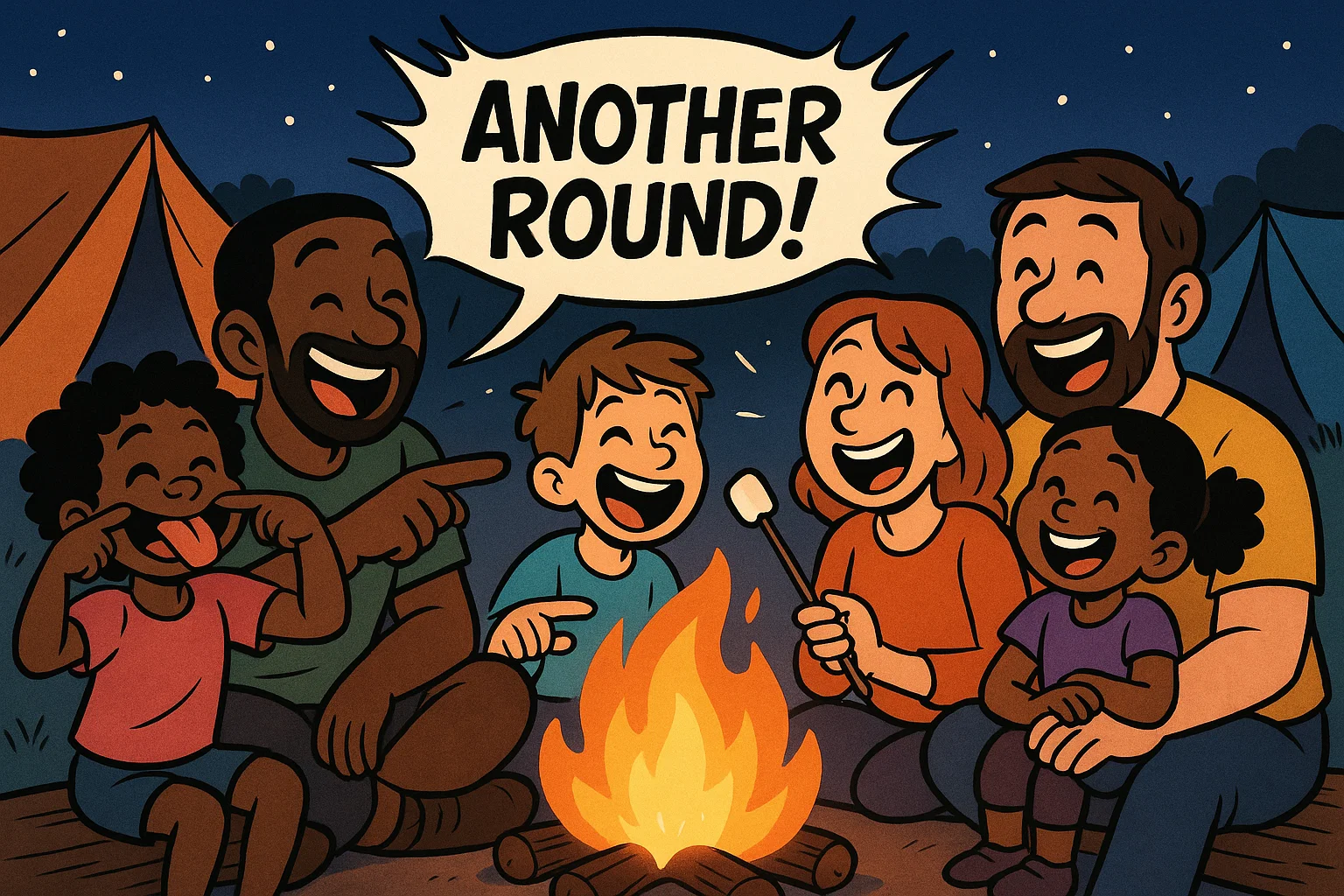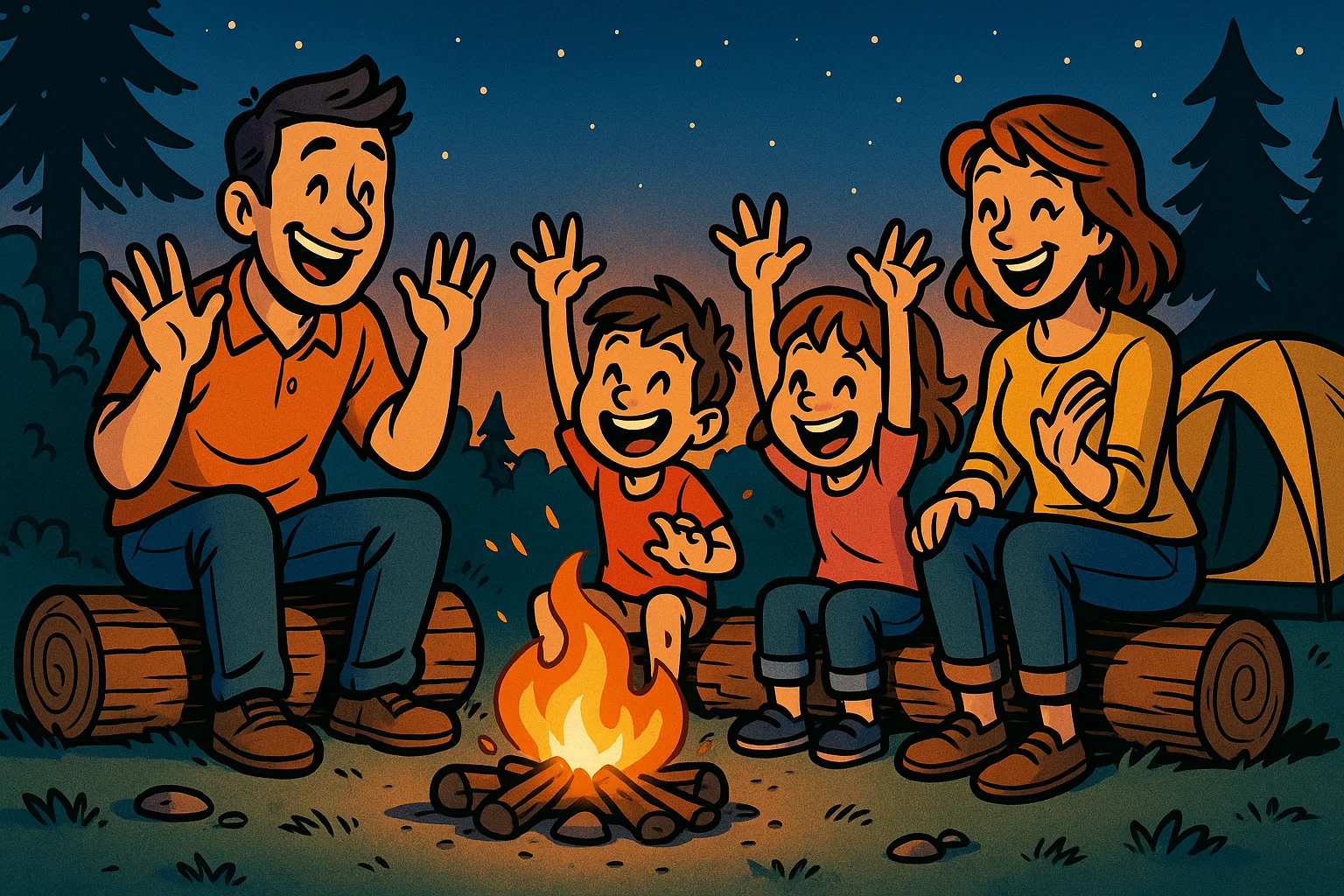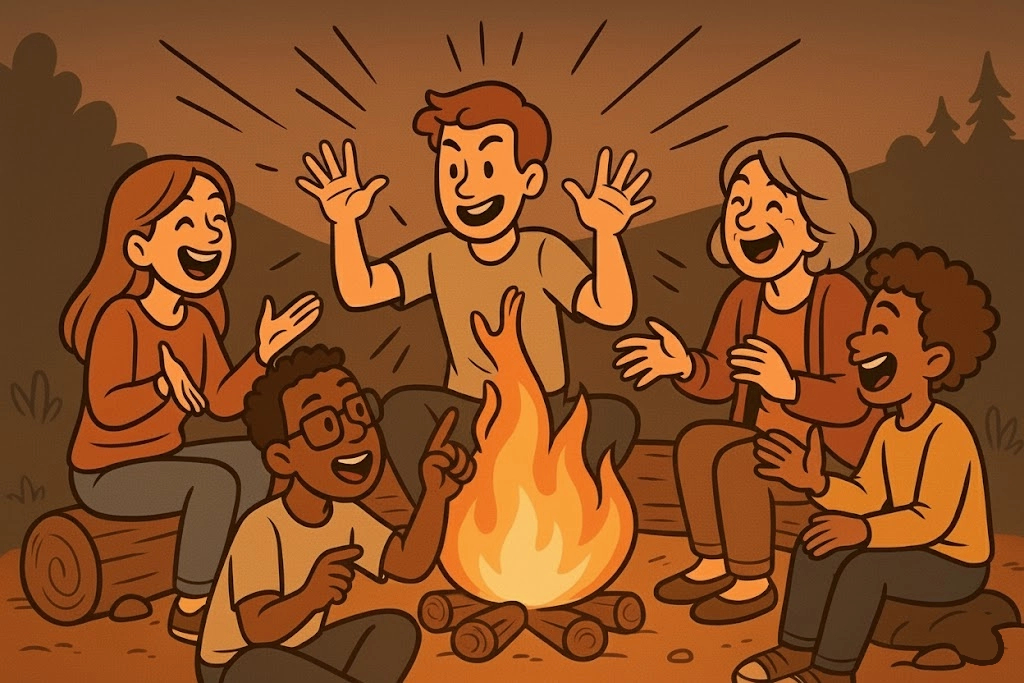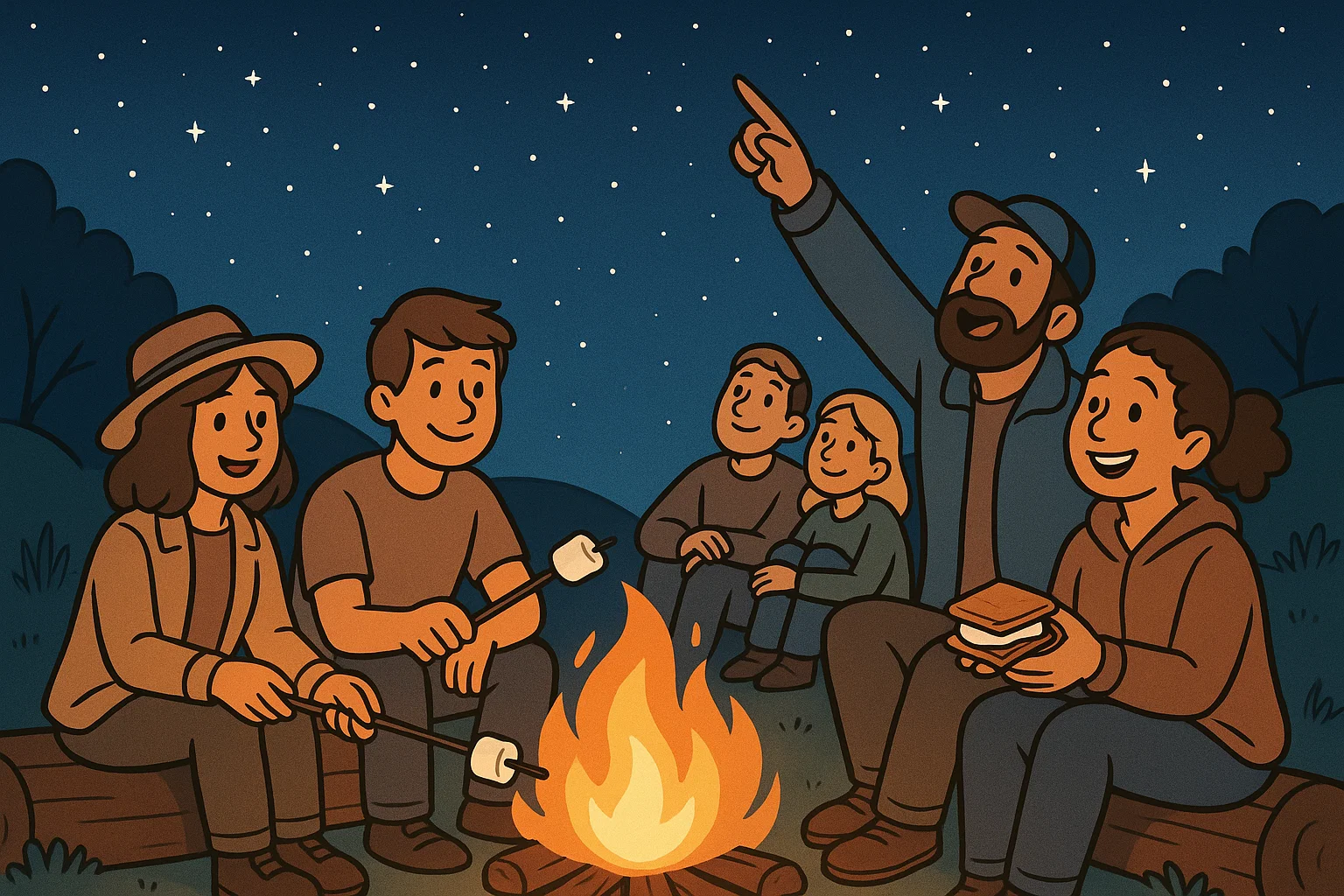9 Fun Campfire Games to Play Around the Fire: For Adults, Kids, and Families

There’s something timeless about gathering around a campfire. The crackling flames, the smell of smoke, and the warmth on a cool evening create the perfect backdrop for connection and laughter. Whether you’re on a camping trip with young children, teenagers, or a group of adults, having a repertoire of fun campfire games can transform an ordinary evening into a memorable experience.
The best campfire games require minimal equipment—often just your imagination and the people sitting around the circle. From guessing games that spark creativity to drinking games for grown-ups, this guide covers activities that bring people together without complicated rules or extensive preparation. You’ll find options for every age group and energy level, ensuring everyone can participate and enjoy the warmth of both fire and friendship.
Fun Campfire Games for Kids and Families When Camping

Family camping trips thrive on inclusive activities that engage everyone from the youngest camper to the adults. The campfire circle naturally encourages participation, and kids and families can bond over simple, laughter-filled moments.
What makes a great family campfire game:
- Simple rules that even young children can understand quickly
- No special equipment beyond what you already have at camp
- Flexible player count that works whether you have 4 or 14 people
- Short rounds that match children’s attention spans
- Inclusive participation where everyone can contribute regardless of age
Simple Games Around the Campfire for Young Children
Young children need games that hold their attention without overly complex instructions. The key is choosing activities that allow for movement, creativity, and quick rounds that match shorter attention spans.
Animal Sounds Game works beautifully for preschoolers and early elementary children. One person thinks of an animal and makes its sound while others guess. This game can continue around the circle with each child taking a turn. It’s simple enough that even three-year-olds can participate, yet entertaining enough that older kids and adults enjoy the silliness.
Pass the Clap creates rhythm and focus. Everyone sits in the campfire circle, and one person starts by making eye contact with the person next to them and clapping once. That person passes the clap to the next person in the direction of play. The game starts slowly but can speed up or change directions, creating anticipation and giggles when someone breaks the pattern.
Campfire Singing Games
Music naturally draws people together around the fire. Classic songs like “The Wheels on the Bus” or “If You’re Happy and You Know It” get young children moving and participating. For slightly older kids, try cumulative songs like “There’s a Hole in the Bottom of the Sea” or “Down by the Bay,” where each verse builds on the previous one.
“Name That Tune” campfire edition requires no special equipment. One person hums or whistles a familiar song, and others race to guess it first. You can adapt difficulty based on your group—Disney songs for younger kids, classic rock for teens, or current pop hits for everyone.
Shadow Puppets and Flashlight Fun
Flashlights and the natural darkness around a campfire create perfect conditions for shadow entertainment. Hold your hands between a flashlight and a light-colored surface (a tent wall, a sheet, or even someone’s back) to create animals, birds, or imaginary creatures.
This activity combines creativity with storytelling. Older kids can create elaborate shadow puppet shows while younger children marvel at simple shapes. According to research from ResearchGate, shadow play enhances spatial reasoning and imaginative thinking, making it both educational and enjoyable.
Hilarious Campfire Guessing Games
Guessing games tap into natural curiosity and creativity. They work for mixed-age groups because you can adjust complexity on the fly, and they generate genuine laughter and engagement.
Twenty Questions Variations
This classic game adapts beautifully to the campfire setting. Choose one person to think of something—an object, animal, or person. Others take turns asking yes-or-no questions, trying to identify the secret word or item within twenty questions.
For camping-themed fun, limit answers to things you might encounter outdoors: animals, plants, camping equipment, or natural features. This variation keeps the game relevant and helps children learn about their environment. A study published in Cognitive Development found that question-asking games improve critical thinking skills in children ages 7-12.
The Alphabet Game adds structure to guessing. Choose a category (animals, foods, camping items), and go around the circle naming items that begin with each letter in order. When someone can’t think of a word that begins with the assigned letter, they’re out, and the game continues until one person remains.
Charades and Mimic Games
Charades needs no introduction, but the campfire version has special appeal. The flickering firelight creates dramatic shadows, and the outdoor setting encourages bigger, bolder movements. Write suggestions on slips of paper beforehand (animals, camping activities, famous characters), and let players draw randomly.
For families with young children, simplify to animal charades where everyone acts out creatures they might see while camping and hiking. Older kids and adults can tackle more challenging concepts, actions, or phrases.
Mirror Game pairs people up, with one person leading movements and their partner mimicking exactly. Switch roles after a minute. This works well as a warm-up before charades and helps shy participants loosen up.
Group Memory Circle Challenges
Memory games naturally suit the circular campfire arrangement and can be adjusted for any age group.
I’m Going on a Camping Trip builds sequentially. The first person says, “I’m going on a camping trip, and I’m bringing…” followed by an item (like “a tent”). The next person repeats the phrase, the first item, and adds their own. This continues around the circle, with the list growing longer. When someone forgets an item or the order, they’re out, but the game continues until only one person remains.
For added challenge, make items alliterative (“I’m bringing a big blue blanket”) or categorical (only food items, only things that start with specific letters).
Campfire Story Building exercises collective creativity. One person begins a story with a single sentence. The next person adds another sentence, and so on around the circle. The story often takes hilarious, unexpected turns, especially with mixed age groups. This activity encourages active listening and spontaneous creativity—skills that educational psychologist Dr. Sandra Russ notes are crucial for cognitive flexibility.
Interactive Games to Play Around the Campfire

Moving beyond strictly verbal games, interactive activities add physical elements while maintaining the inclusive campfire circle format. These games work particularly well when energy levels are high earlier in the evening.
Quick Reference: Campfire Games by Group Size and Age
| Game Name | Best For | Players | Energy Level | Setup Time |
| In the Pond, Out of the Pond | Kids & Families | 6-20 | High | None |
| Telephone | All Ages | 6-15 | Low | None |
| Celebrity Name Game | Teens & Adults | 8-20 | Medium | 5 min (writing names) |
| Charades | All Ages | 4-12 | High | 5 min (optional slips) |
| Twenty Questions | All Ages | 3-10 | Low | None |
| Mafia | Teens & Adults | 7-20 | Medium | None |
| Contact | Adults | 4-10 | Low | None |
| Never Have I Ever | Adults | 4-15 | Low | None |
| Story Building | Families | 4-12 | Low | None |
Games to Play: How to Play Them
Clear instructions make the difference between confusion and fun. Here are several interactive games with straightforward rules that people of all ages can quickly grasp.
In the Pond, Out of the Pond (Shoe Flip)
This simple elimination game gets everyone moving. All players sit around the campfire circle with their shoes in front of them. When the leader calls “In the pond!” everyone puts their feet forward, touching their shoes. When the leader says “Out of the pond!” everyone pulls their feet back.
The leader calls commands quickly and randomly, occasionally faking movements or saying “On the lily pad!” or other distractors. Anyone who moves incorrectly is eliminated. The game continues until only one person remains. It’s surprisingly challenging and creates lots of laughter, especially when the leader speeds up or uses similar-sounding phrases to confuse players.
For a variation, use actual objects placed in a circle, and players must physically jump in or out. This version works better for kids and adds more physical activity.
Telephone or Poison Dart Frog
The classic Telephone game translates perfectly to campfire settings. One person whispers a phrase or sentence to the person next to them, who whispers what they heard to the next person, continuing around the circle until reaching the last player. That person announces what they heard, often hilariously different from the original message.
Poison Dart Frog variation adds complexity. The starting phrase must include an animal, action, and location (like “A zebra danced in the grocery store”). As the phrase travels around the circle, see how much changes. This version especially appeals to kids who love animals and silly scenarios.
Celebrity Name Game
This fast-paced game works best with teens and adults but can include older children. Write celebrity names (actors, musicians, athletes, historical figures) on slips of paper. Divide into two teams. Players take turns drawing a name and trying to get their team to guess within a time limit (usually 60 seconds).
The game typically has three rounds with the same names:
- Round One: Describe the celebrity using any words except their name
- Round Two: Use only three words to describe them
- Round Three: Act out the celebrity (charades-style) with no words
This structure creates hilarious moments as people struggle to convey information with increasing restrictions. Teams earn points for each correct guess, and scores accumulate across rounds.
Campfire Story Variations
Storytelling around the campfire has ancient roots, and modern variations keep this tradition alive while adding game elements.
Ghost Stories with Interruptions lets one person begin a spooky tale. At random intervals, the storyteller points to someone in the circle, who must continue the story for 30 seconds before passing it to someone else. The unpredictability creates suspense and ensures everyone stays engaged, even shy participants who might not volunteer to speak.
Two Truths and a Lie campfire edition asks each person to share two true camping or outdoor experiences and one made-up story. Others vote on which story is false. This game helps people learn about each other while generating interesting conversations. It works particularly well for groups who don’t know each other well, like scout troops or family reunions.
Fortune Teller Stories require one person to “predict” what will happen on the camping trip. They make exaggerated, silly predictions (“Tomorrow, Marcus will befriend a raccoon who steals his sandwich”). As the trip progresses, the group tries to make predictions come true or notices when they happen naturally, creating inside jokes and shared memories.
Campfire Games for Teens and Adults
As the evening progresses and younger children head to bed, games can become more sophisticated. Teens and adults appreciate activities that challenge quick thinking, creativity, and strategy without requiring physical props or complicated setup.
Word Association and Team Strategy Games
Contact is a challenging word game that rewards clever thinking. Choose one person to be “it.” They think of a secret word and tell everyone the first letter. Other players try to guess the word by forming associations. When two or more players think they have the same association (starting with that letter), they make “contact” by saying “Contact!” The person who is “it” has three seconds to guess what word they’re thinking of. If they guess correctly, nothing happens. If they fail, the two players count to three and say their word simultaneously. If they match, the person who is “it” must reveal the next letter of their secret word.
This continues until someone guesses the complete word. It’s surprisingly engaging and can last 20-30 minutes with a good word.
Word Chain requires each person to say a word that starts with the last letter of the previous word. For example: “campfire → elephant → turtle → emerald.” Players have only three seconds to respond. Anyone who hesitates, repeats a word, or can’t think of anything is eliminated. Make it harder by adding category restrictions (only nature words, only foods, only verbs).
Fortunately/Unfortunately alternates optimistic and pessimistic story elements. One person begins: “Fortunately, we brought marshmallows.” The next person continues: “Unfortunately, we forgot the chocolate.” The next: “Fortunately, we found wild berries nearby.” This pattern continues around the circle, often creating absurd scenarios that have everyone laughing.
Unique Games: Balderdash and Mafia
Balderdash campfire edition works without the board game. One person finds an obscure word (bring a dictionary or use a phone) and announces it. Everyone except the reader writes a fake definition designed to sound plausible. The reader collects all definitions, adds the real one, and reads all options aloud. Players vote on which definition they think is correct, earning points for guessing correctly or fooling others with their definition.
This game reveals who’s creative, who’s strategic, and who can deliver a convincing bluff with a straight face. A study by cognitive scientists at UC Berkeley found that games requiring creative deception activate multiple brain regions simultaneously, making them mentally stimulating while entertaining.
Mafia (also called Werewolf) is perhaps the best campfire game for teens and adults, combining strategy, deception, and group dynamics. Choose one person as the narrator. Everyone else closes their eyes while the narrator taps certain people to be “mafia members” (usually 2-3 depending on group size).
The game alternates between night and day phases:
- Night: Everyone closes their eyes. Mafia members silently agree on someone to “eliminate.” The narrator notes their choice.
- Day: Everyone opens their eyes, and the narrator announces who was eliminated (they’re out). The group discusses who might be mafia and votes to eliminate one suspected person.
The game continues until either all mafia members are eliminated (town wins) or mafia equals or outnumbers remaining town members (mafia wins). The narrator’s dramatic storytelling and players’ accusations and defenses create incredibly engaging gameplay that can last over an hour.
Spot the Leader (Concentration Game)
This observational game tests attention to detail. Choose one person to leave the circle (ideally they walk into a tent or far enough away that they can’t hear). The remaining group silently selects a “leader” who will initiate movements (clapping, waving, tapping head, etc.). Everyone else copies the leader’s movements as quickly and seamlessly as possible.
The person returns and stands in the center of the circle, watching carefully to identify who is initiating the changes. The leader must subtly change movements when the guesser isn’t directly looking at them. If the guesser identifies the leader within three guesses, the leader becomes the new guesser. If they fail, they stay in the middle for another round.
This game becomes increasingly challenging as players get better at disguising leadership and synchronizing movements. It rewards peripheral vision and subtle observation—skills that wilderness guide and author Tom Brown Jr. describes as essential for outdoor awareness.
Engaging Activities for Adults Around the Campfire

Not every campfire gathering needs competitive games. Some of the most memorable moments come from activities that foster creativity, connection, and appreciation for the natural setting.
Campfire Cooking Recipes (Like S’mores)
Collaborative cooking turns eating into entertainment. While s’mores are the classic choice—and for good reason—expanding your campfire cooking repertoire creates new experiences.
Essential Campfire Cooking Supplies to Pack:
- Long roasting sticks or skewers (at least 30 inches)
- Heavy-duty aluminum foil for packet cooking
- Heat-resistant gloves or oven mitts
- Grill grate or cooking tripod (optional but useful)
- Tongs for handling hot items
- Small cutting board and knife
- Plates and napkins for serving
S’mores Variations elevate the traditional treat. Try using different cookies (Thin Mints, Nutter Butters, Biscoff), add peanut butter or Nutella, use dark chocolate or caramel-filled chocolate, or experiment with flavored marshmallows. Setting up a “s’mores bar” with multiple options lets everyone customize their creation.
Campfire Cones offer a fun alternative: fill waffle cones with chocolate chips, marshmallows, fruit, and other toppings, wrap in foil, and warm by the fire for 5-7 minutes. Each person can create their own combination, and the cone contains the melted goodness.
Foil Packet Dinners can be prepared together, sharing recipes and techniques. As they cook in the coals, the anticipation and wonderful smells create conversation and connection.
Bannock Bread on sticks is a traditional camping food that involves twisting dough around a stick and cooking it over the fire. Once cooked, fill the hollow center with honey, jam, or chocolate spread. The process is meditative and produces delicious results.
Stargazing: Identification and Stories
As the fire dies down and eyes adjust to darkness, stargazing becomes a natural next activity. The darker sky away from city lights reveals countless stars, planets, and celestial phenomena.
Constellation Identification works best with a stargazing app or printed star chart. Take turns finding and pointing out constellations, planets, and notable stars. Learning to spot Polaris (North Star) using the Big Dipper is a practical skill campers can use for navigation.
Mythological Stories accompany many constellations. Ancient Greeks, Romans, Native Americans, and cultures worldwide created stories explaining celestial patterns. Sharing these narratives connects modern campers to thousands of years of human history and imagination. Orion the Hunter, Cassiopeia the Queen, Ursa Major and Minor—each has rich mythology.
Meteor Watching during peak times (Perseids in August, Geminids in December) provides natural entertainment. According to NASA, major meteor showers can produce 50-100 visible meteors per hour under ideal conditions. Lying on blankets, watching for shooting stars, and making wishes creates peaceful, reflective moments.
Astronomy Trivia can continue education while maintaining game elements. Questions about planets, space exploration, moon phases, or astronomical phenomena test knowledge and spark interesting discussions about the universe. The combination of hands-on observation and factual learning makes astronomy particularly engaging in the outdoor setting.
